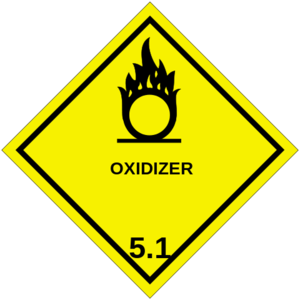HAZMAT1962 disaster leads to stricter hazmat transportation regulations
Federal transportation law requires all vehicles carrying hazardous materials to display information placards, diamond-shaped, color-coded signs with numbers and symbols posted at various points on the truck; the law is the result of a 1962 Connecticut accident, in which four fire fighters died because they were not aware of the hazardous material a truck, which was on fire, was carrying

HAZMAT placard displaying critical information for first responders // Source: wikimedia.org
Federal transportation law requires all vehicles carrying hazardous materials to display information placards, diamond-shaped, color-coded signs with numbers and symbols posted at various points on the truck.
In the event of an emergency, such as a truck fire or collision, first responders are able to determine from a safe distance exactly what is nature of the hazardous cargo and equip themselves accordingly before approaching. These regulations are an outcome of a 1962 tragedy in Norwich, Connecticut, which claimed the lives of four firefighters and injured several others.
There were no such laws in place on 3 April 1962, when Norwich firefighters responded to a call from the Van Tassel Leather Company. The callers reported that they had a truck fire at the factory, and that the truck was loaded with explosives. There was no other indication of the nature of the material aboard the truck.
The subsequent explosion leveled parts of the warehouse and shattered glass for miles around, reports the Norwich Bulletin.
Norwich Fire Marshal Kenneth Scandariato said that in the 1960s, it was understood that certain chemicals were volatile, but that understanding was from a chemical composition perspective, rather than a safety perspective. Unlike today, there was very little in the way of training for dealing with hazardous materials responses.
Major Carrol Shaw, the deputy state fire marshal at the time, reported that the load carried by the truck was organic peroxides and that the load was extremely sensitive to shock, blows, and impact, and likely shifted during the trip from Buffalo, New York to Norwich.
It was in this report that Shaw recommended the color-coded placard system, which the state supported. It is this system which is federal law today.
The 1975 Hazardous Materials Transportation Act, among other controls on the transport and delivery of hazardous materials, required the placement of the familiar diamond-shaped signs commonly seen on most trucks on our highways.
These conspicuously placed signs include coding corresponding to an annually updated guidebook which is carried by all first responders, giving them detailed information on the nature of the load being carried and appropriate response measures.
There has also been an increase in hazmat response training. According to William Eyeburse, an instructor at the Eastern Connecticut Fire Academy, said that every level of fire service receives at least some form of hazardous material response training. Eyeburse said “Just about every fire truck, ambulance and police cruiser carries a copy of the DOT emergency response guide book with 1,500 of the most commonly transported hazardous materials.”
